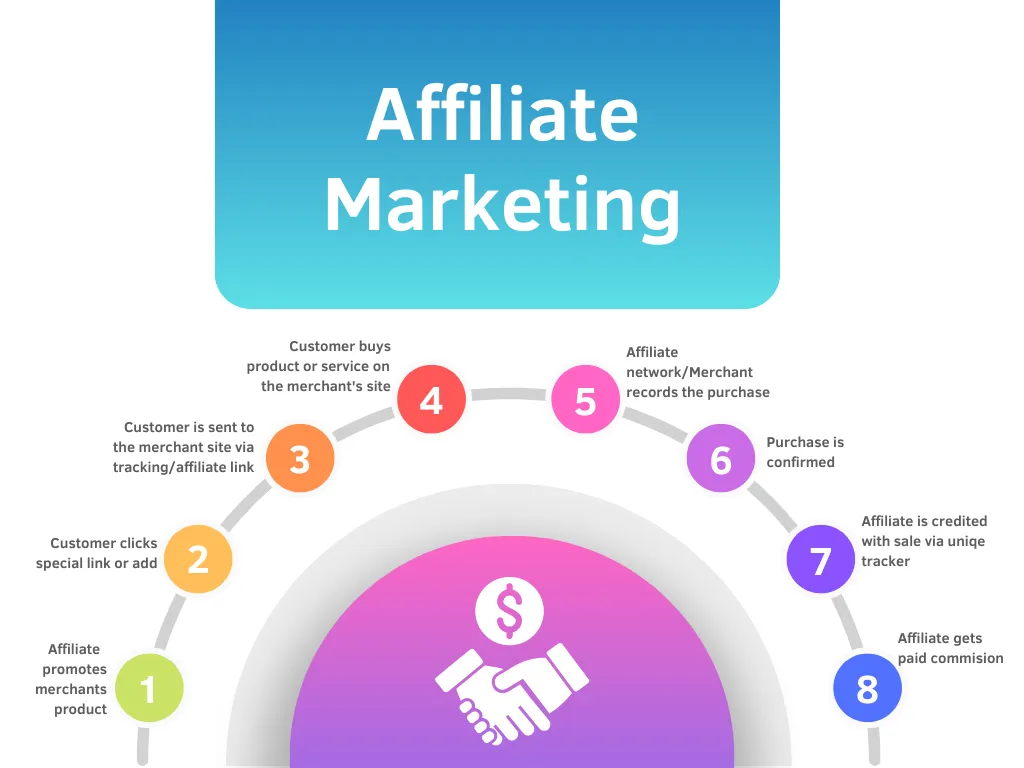Introduction
What is Affiliate Marketing?
Affiliate marketing is a performance-based marketing strategy where businesses reward external partners, known as affiliates, for generating traffic or sales through the affiliate’s marketing efforts. It’s a win-win situation: businesses increase their reach and sales, while affiliates earn commissions for their promotional efforts.
The Digital Marketing Landscape
In today’s digital age, marketing isn’t just about putting out advertisements and hoping for the best. It’s about building genuine relationships and leveraging various online channels to reach a target audience. Among these channels, affiliate marketing stands out as a powerful tool. It’s a bridge that connects businesses with potential customers through trusted influencers or content creators. This method has become increasingly popular because it offers a more personalized approach to marketing, tapping into the trust that affiliates have built with their audience.
Why This Guide Matters
This guide is designed to provide a comprehensive overview of affiliate marketing. Whether you’re a business looking to set up an affiliate program or an individual considering becoming an affiliate, this guide will offer valuable insights. We’ll delve deep into the history, the various types, the benefits, and much more. By the end of this guide, you’ll have a clear understanding of the affiliate marketing landscape and how you can make the most of it.
History of Affiliate Marketing
The Beginnings: Origins and Early Days
Affiliate marketing, though it seems like a modern concept, has roots that date back long before the internet era. The basic principle of earning a commission for referring a new customer is an age-old practice. However, the term “affiliate marketing” began to gain traction in the late 1990s. The concept was simple: online businesses would provide unique links to individuals or other businesses, and if someone made a purchase using that link, the referrer would earn a commission.
Evolution Over the Years
As the internet grew, so did the opportunities for affiliate marketing. Early pioneers of this model included Amazon, which launched its affiliate program in 1996. This allowed website owners to advertise products from Amazon on their sites and earn a percentage of the sales. The success of such programs led to a surge in businesses adopting the affiliate marketing model.
With the rise of blogging, social media, and influencer culture in the 2000s and 2010s, affiliate marketing found new avenues for growth. Affiliates began leveraging these platforms to promote products and services, leading to a more diverse and dynamic affiliate marketing landscape.
Major Milestones in Affiliate Marketing
- 1996: Amazon launches its “Associates Program,” setting a precedent for online affiliate marketing.
- 2000: The Federal Trade Commission (FTC) releases guidelines for disclosure, ensuring transparency in affiliate promotions.
- 2010s: The rise of influencers on platforms like Instagram and YouTube offers new opportunities for affiliate partnerships.
- 2020 and beyond: With advancements in technology, particularly in tracking and analytics, businesses and affiliates can optimize their strategies more effectively, ensuring better ROI and more personalized marketing efforts.
Basics of Affiliate Marketing
How It Works: The Process Explained

Affiliate marketing works is a straightforward process, but it involves several key steps. First, a business decides to set up an affiliate program and invites individuals or other businesses to join as affiliates. Once accepted, the affiliates receive unique tracking links to promote the business’s products or services. When a customer clicks on an affiliate’s link and makes a purchase, the affiliate earns a commission. The entire process is tracked through affiliate marketing software, ensuring accurate attribution of sales to the respective affiliates.
Key Players in Affiliate Marketing
Affiliates
Affiliates, also known as publishers or partners, are individuals or businesses that promote a company’s products or services. They can range from bloggers and influencers to large media companies. Affiliates use their platforms to reach their audience and drive traffic or sales to the business they’re promoting.
Merchants
Merchants, also known as advertisers or retailers, are the businesses that offer affiliate programs. They provide the products or services that affiliates promote. Merchants set the terms of the affiliate program, including commission rates and payment schedules.
Networks
Affiliate networks act as intermediaries between affiliates and merchants. They provide a platform where merchants can list their affiliate programs, and affiliates can find suitable programs to join. Networks handle tracking, reporting, and payment processing, making it easier for both parties to manage their affiliate relationships.
Consumers/Customers
Consumers are the end-users who make purchases through affiliate links. They are the driving force behind affiliate marketing, as their actions determine the commissions earned by affiliates.
You Might Also Like:
Benefits of Affiliate Marketing
Affiliate marketing offers a wide range of benefits for all parties involved. Let’s explore the advantages for merchants, affiliates, and consumers.
Benefits For Merchants

Cost-Effective Marketing
Affiliate marketing is performance-based, meaning merchants only pay commissions when a sale is made or a specific action is taken. This makes it a cost-effective marketing strategy, as merchants don’t incur expenses without seeing results.
Increased Reach and Sales
By partnering with affiliates, merchants can tap into new audiences and expand their reach. Affiliates bring in traffic and potential customers that merchants might not have access to otherwise, leading to increased sales.
Low Risk
Since merchants only pay for actual sales or actions, there’s minimal risk involved in affiliate marketing. Merchants don’t have to worry about spending money on marketing efforts that don’t yield results.
Benefits For Affiliates

Earning Potential
Affiliates can earn commissions by promoting products or services they believe in. The earning potential is virtually limitless, as it depends on the affiliate’s reach, the products they promote, and the commission structure.
Flexibility
Affiliate marketing offers flexibility in terms of working hours and location. Affiliates can work from anywhere and set their own schedules, making it an attractive option for those seeking a more flexible lifestyle.
Low Entry Barriers
Becoming an affiliate doesn’t require significant upfront investment or technical expertise. Anyone with an online presence, whether it’s a blog, social media account, or YouTube channel, can become an affiliate.
Benefits For Consumers

Access to Trusted Recommendations
Consumers often turn to trusted influencers or content creators for product recommendations. Affiliate marketing allows consumers to discover and purchase products endorsed by individuals they trust.
Informed Purchasing Decisions
Affiliates often provide in-depth reviews, comparisons, and insights into the products they promote. This valuable information helps consumers make informed purchasing decisions.
You Might Also Like:
Types of Affiliate Marketing
Understanding the different types of affiliate marketing is essential for beginners to find the right strategy that suits their goals. Whether you’re interested in content marketing, social media promotion, or paid advertising, knowing your options can help you choose the best path to success.
Pay-Per-Click (PPC)
In a PPC (Pay-Per-Click) model, affiliates earn commissions based on the number of clicks generated through their affiliate links, even if those clicks don’t result in a sale. This model is somewhat less common because it doesn’t directly correlate with sales. However, it can be appealing to affiliates with a substantial audience, allowing them to earn money merely by directing traffic to the merchant’s site. For optimizing your PPC campaigns, a proper PPC Competitor Analysis is crucial. Enhance your strategy further by exploring these essential pay-per-click tools.
For example:
John, who runs a popular tech blog, joins the affiliate program of TechGadget, an online store selling tech gadgets. Through the program, he promotes a smartwatch from TechGadget using a unique affiliate link in one of his blog posts. TechGadget’s affiliate program operates on a Pay-Per-Click (PPC) commission model. This means that for every click on John’s affiliate link, he earns a commission, regardless of whether the visitor makes a purchase. Over a month, the link in John’s post generated 1,000 clicks. With a commission rate of $0.10 per click, John earns $100 from this PPC campaign.
Also read: PPC Optimization – 6 Key Aspects for Success
Pay-Per-Lead (PPL)
PPL affiliate programs reward affiliates for generating leads. Affiliates earn a commission when a visitor takes a specific action, such as signing up for a newsletter, filling out a contact form, or registering for a webinar. This model is particularly popular in industries where the sales process is longer and involves nurturing leads, such as B2B services or high-ticket items.
For example:
Sarah, a fitness blogger, partners with FitLife, an online fitness coaching service, through their affiliate program. FitLife’s affiliate program operates on a Pay-Per-Lead (PPL) commission model. Sarah promotes FitLife’s coaching services in her blog posts and includes a unique affiliate link that directs readers to a sign-up page for a free trial of FitLife’s services. For every visitor who clicks on Sarah’s affiliate link and signs up for the free trial, Sarah earns a commission. Over a month, Sarah’s promotion resulted in 50 sign-ups for FitLife’s free trial. With a commission rate of $5 per lead, Sarah earns $250 from this PPL campaign.
In this example, Sarah earns a commission for every visitor who clicks on her affiliate link and completes a specific action (signing up for a free trial), regardless of whether they make a purchase. This is the essence of a Pay-Per-Lead affiliate marketing model.
Pay-Per-Sale (PPS)
PPS is the most common affiliate marketing model. Affiliates earn a commission when a sale is made through their referral link. The commission can be a fixed amount or a percentage of the sale. This model is favored by merchants, as they only pay for actual sales, ensuring a direct return on their marketing investment.
For example:
Alex, who runs a travel blog, partners with Wanderlust Adventures, an online travel agency, through their affiliate program. Wanderlust Adventures’ affiliate program operates on a Pay-Per-Sale (PPS) commission model. Alex promotes Wanderlust Adventures’ vacation packages in his blog posts and includes a unique affiliate link that directs readers to the agency’s booking page. For every visitor who clicks on Alex’s affiliate link and makes a purchase, Alex earns a commission. Over a month, Alex’s promotion results in 10 bookings of vacation packages through Wanderlust Adventures. With a commission rate of $50 per sale, Alex earns $500 from this PPS campaign.
Content Sites vs. Review Sites
Content Sites
Content sites focus on creating valuable content around a specific niche, incorporating affiliate links naturally within the content. These sites often feature articles, blog posts, or tutorials related to the niche, providing useful information to their audience. Affiliates can seamlessly integrate product recommendations and affiliate links within the content, making it a non-intrusive way to promote affiliate products.
Review Sites
Review sites specialize in providing in-depth reviews and comparisons of products or services, helping consumers make informed purchasing decisions. These sites often feature detailed analyses, pros and cons, and user testimonials. Affiliates can earn commissions by directing readers to the merchant’s site through their affiliate links, usually placed within the review or in a comparison table.
You Might Also Like:
Influencer-Driven Affiliate Marketing
Influencers leverage their large following on social media or other platforms to promote products or services. They often use a more personal approach, sharing their experiences and opinions about the products they promote. Influencers can create engaging content, such as unboxing videos, tutorials, or lifestyle posts, incorporating affiliate links naturally within the content or in the post description.
Also read: Navigating the Influencer Affiliate Marketing Landscape
Email List Affiliates
Email list affiliates use email marketing to promote affiliate products. They build a list of subscribers and send targeted email campaigns, including affiliate links, to their audience. Affiliates can segment their email list based on subscriber preferences, ensuring that the promotions are relevant and tailored to the audience’s interests.
Webinars and Video-Based Affiliates
Some affiliates use webinars or video content to promote products or services. They create informative and engaging videos, incorporating affiliate links in the video description or during the presentation. Webinars can be particularly effective for promoting high-ticket items or services, as affiliates can provide in-depth explanations, demonstrations, and answer live questions from the audience.
Other Lesser Used Types of Affiliate Marketing
Beyond the more common models like PPC, PPL, and PPS, there are additional affiliate marketing strategies worth exploring. For example, Two-Tier Affiliate Marketing allows affiliates to earn commissions not just on their own sales but also from sales made by affiliates they refer. Sub-Affiliate Marketing enables affiliates to promote entire networks, earning a percentage of what their sub-affiliates generate. While these models are less commonly used, they offer unique ways to scale earnings in the affiliate marketing ecosystem.
Setting Up and Succeeding in Affiliate Marketing
Deciding on a Niche

Choose a niche that aligns with your interests and expertise. Consider your target audience, market demand, and the unique selling points of the products or services within that niche. Select a niche that you’re passionate about and has the potential to attract an audience and generate sales.
As an affiliate marketer, setting up and succeeding in affiliate marketing involves several key steps. Here’s a comprehensive guide to help you get started and achieve success.
Researching and Joining Affiliate Programs
To effectively research affiliate programs relevant to your niche, start by exploring those that offer products or services your audience will find valuable. Prioritize programs with a strong reputation, attractive commission rates, and reliable tracking and payment systems. When you find suitable programs, apply to join them by providing details about your website, social media profiles, or other promotional platforms. After your application is approved, you will receive unique affiliate links to share and promote the products or services. For more detailed steps on this process, check out our guide on how to find and join the best affiliate programs for beginners.
Creating Quality Content
Create high-quality content that resonates with your target audience. Incorporate your affiliate links naturally within the content, providing valuable information and insights related to the products or services you’re promoting. Content can include blog posts, videos, social media posts, or email newsletters.
Building a Trustworthy Online Presence
Establish yourself as an authority in your niche by consistently providing valuable content and engaging with your audience. Respond to comments, share user-generated content, and participate in relevant groups or communities. Building trust with your audience is crucial for long-term success in affiliate marketing.
Promoting Your Content
Search Engine Optimization (SEO)
Optimize your content for search engines by using relevant keywords, creating high-quality content, and building backlinks. This will help your content rank higher in search engine results, driving organic traffic to your site.
Social Media Marketing
Share your content on social media platforms and engage with your audience. Use eye-catching visuals, compelling captions, and relevant hashtags to increase your content’s visibility and reach.
You Might Also Like:
Email Marketing
Build an email list and send regular newsletters to your subscribers. Share your latest content, exclusive offers, and valuable insights. Personalize your emails to increase engagement and build a loyal audience.
You Might Also Like:
Influencer Partnerships
Collaborate with influencers in your niche to reach a wider audience. Influencers can share your content, mention you in their posts, or create co-branded content.
Paid Advertising
Invest in paid advertising to boost your content’s visibility. Use platforms like Google Ads, Facebook Ads, or Instagram Ads to target specific demographics and drive traffic to your content.
Guest Posting
Write guest posts for reputable websites in your niche. Include your affiliate links within the content or in your author bio. This will help you reach a new audience and build backlinks to your site.
Monitoring and Optimizing Your Campaigns
Regularly monitor and analyze the performance of your affiliate marketing campaigns. Track key metrics like clicks, conversions, and commissions earned. Evaluate what’s working and what’s not, and make adjustments to optimize your campaigns. Experiment with different content formats, promotional strategies, or affiliate programs to find what works best for you. Additionally, consider adapting your attribution models as the digital landscape evolves to ensure you accurately assess the effectiveness of different channels and refine your strategies accordingly.
Challenges in Affiliate Marketing
Affiliate marketing can be a lucrative venture, but it’s not without its challenges. Here are some common obstacles affiliate marketers face and how to overcome them.
See also: 6 Tips on How to Avoid Distractions When Working from Home
Fraudulent Activities and How to Prevent Them
Click Fraud
Click fraud occurs when individuals or bots repeatedly click on an affiliate link without any intention of making a purchase. This can lead to skewed data and affect an affiliate’s earnings.
Prevention:
- Use Anti-Fraud Software and Services: There are specialized software and services designed to detect and prevent click fraud. These tools analyze click patterns, IP addresses, user behavior, and other data to identify suspicious activity. Examples of such software include ClickCease, Fraudlogix, and Anura.
- Monitor Traffic Sources: Regularly monitor your traffic sources and analytics to identify unusual spikes in clicks. If you notice sudden increases in clicks without a corresponding increase in conversions, it might be a sign of click fraud.
- Implement Click Caps: Set a limit on the number of clicks a user can generate from a single IP address within a specific time frame. This can help prevent excessive clicking and fraudulent activity.
- Use Captchas and Validation: Implement captcha challenges or validation steps before a click is registered. This can deter automated bots from generating fake clicks.
- Geo-Targeting and IP Blocking: Geo-targeting allows you to focus on specific regions and block traffic from high-risk regions known for fraudulent activities. IP blocking prevents clicks from known suspicious IP addresses.
- Employ IP Filtering: Use IP filtering to block clicks from proxy servers, data centers, and other sources often used by fraudsters.
- Fraud Detection Rules: Set up rules in your tracking software to flag clicks that exhibit suspicious behavior, such as rapid clicks from the same IP address or multiple clicks from the same device.
- Regularly Audit Traffic: Conduct regular audits of your affiliate traffic to identify patterns or inconsistencies. Look for instances where a few sources are generating a disproportionately high number of clicks.
- Communicate with Affiliate Managers: Maintain open communication with the affiliate program managers. If you suspect click fraud, report your findings to them and seek their assistance in investigating the issue.
- Educate Yourself: Stay informed about the latest click fraud tactics and strategies. Knowledge is your best defense against evolving fraud techniques.
Cookie Stuffing
Cookie stuffing involves placing an affiliate tracking cookie on a user’s device without their knowledge or consent. This can result in affiliates earning commissions for sales they didn’t genuinely refer to.
Prevention:
- Only Work with Reputable Affiliate Programs: Collaborate exclusively with affiliate programs that maintain strict policies against cookie stuffing. Prioritize partnerships that prioritize transparency and ethical practices.
- Transparently Communicate Affiliate Links: Foster transparency by openly discussing affiliate links with your audience. Clearly elucidate how these links work and the purpose of affiliate tracking cookies to establish trust.
- Regularly Review Your Affiliate Reports: Frequently assess your affiliate reports to detect any irregularities or unexpected commissions. Investigate instances where you appear to earn commissions for sales not genuinely referred by you.
- Monitor User Experience: Keep a close watch on the user experience of your website. If users express concerns about encountering unexpected affiliate links or experiences, promptly investigate for potential cookie stuffing.
- Stay Educated About Cookie Stuffing Techniques: Remain up-to-date about the latest cookie stuffing techniques and strategies employed by fraudulent actors. Equipping yourself with this knowledge empowers you to protect your affiliate marketing endeavors.
- Educate Your Audience: Educate your audience about the risks associated with cookie stuffing and provide guidance on how to distinguish genuine affiliate links. Empower your audience to make informed decisions when interacting with affiliate content.
You Might Also Like:
Navigating Competitive Niches
Some niches are highly competitive, making it challenging for new affiliates to gain traction and earn commissions.
Overcoming:
- Identify Sub-Niches or Micro-Target Audiences:
- Focus on specific sub-niches within the competitive field.
- Tailor content to address the needs of these underserved segments.
- Research and Analyze Your Competitors:
- Understand competitor strategies, content, and audience engagement.
- Identify gaps and opportunities that your competitors may be missing.
- Create Exceptional, Specialized Content:
- Provide valuable content like in-depth guides, video tutorials, and case studies.
- Address pain points directly to offer unique value to your audience.
- Build a Strong Personal Brand:
- Develop a personal brand that resonates with your target audience.
- Share your expertise and personal journey to build trust and connection.
- Leverage Long-Tail Keywords:
- Target specific, less competitive long-tail keywords.
- Attract more targeted traffic to your content.
- Engage Actively on Social Media and Forums:
- Participate in discussions and answer questions on social media and forums.
- Position yourself as an authority and connect with your audience.
- Collaborate with Niche Influencers:
- Build relationships with influencers in your sub-niche.
- Collaborate on content or joint projects to tap into their audience.
- Offer Exclusive Deals or Bonuses:
- Provide exclusive deals, bonuses, or discounts through your affiliate links.
- Incentivize users to choose your recommendations over competitors’.
- Continuously Test and Adapt Strategies:
- Analyze the effectiveness of your strategies using analytics.
- Adjust your approach based on data to optimize results.
- Patience and Persistence:
- Understand that success takes time in competitive niches.
- Stay committed to your strategies and consistently provide value.
Staying Updated with Industry Changes
The affiliate marketing landscape is constantly evolving, with new trends, technologies, and regulations emerging. Keeping in the loop is vital.
Overcoming:
- Follow Industry News and Blogs:
- Subscribe to industry publications and marketing blogs.
- Regularly read updates to stay informed about trends and developments.
- Engage in Online Forums and Communities:
- Participate in discussions on platforms like Reddit, Quora, and affiliate marketing forums.
- Learn from others’ experiences and ask questions about changes in the industry.
- Attend Webinars, Workshops, and Conferences:
- Join webinars and workshops focused on affiliate marketing.
- Attend conferences to learn from experts and network with peers.
- Network with Peers and Experts:
- Connect with professionals on LinkedIn, Twitter, and other social platforms.
- Engage in discussions and share insights with fellow affiliates.
- Subscribe to Affiliate Marketing Podcasts:
- Listen to podcasts for insights, case studies, and practical tips.
- Stay updated while on the go or during downtime.
- Monitor Influencers and Thought Leaders:
- Follow industry influencers on social media and blogs.
- Gain insights from experienced professionals’ perspectives.
- Sign Up for Email Newsletters:
- Subscribe to newsletters from reputable affiliate marketing sources.
- Receive curated content, news, and updates in your inbox.
- Analyze Competitors’ Strategies:
- Study competitors’ campaigns, content, and tactics.
- Identify shifts or trends they’re capitalizing on.
- Stay Informed About Regulatory Changes:
- Keep track of legal and regulatory updates.
- Stay compliant with advertising and privacy regulations.
- Set Aside Dedicated Time:
- Allocate regular time for staying updated.
- Schedule daily or weekly routines for reading and learning.
- Continuously Educate Yourself:
- Invest in online courses, e-books, and educational resources.
- Learn about the latest strategies, tools, and techniques.
You Might Also Like:
Balancing Promotion and Authenticity
Affiliates may struggle to find the right balance between promoting products and maintaining authenticity with their audience.
Overcoming:
- Choose Products You Believe In:
- Prioritize products aligned with your values and interests.
- Promote items you genuinely believe can benefit your audience.
- Test and Experience Products:
- Personally test products to understand their value.
- Share your experiences for authentic recommendations.
- Provide Honest and Transparent Reviews:
- Offer balanced reviews, highlighting the pros and cons.
- Honesty builds trust even when products have flaws.
- Disclose Affiliate Relationships Clearly:
- Transparently disclose affiliations in your content.
- Maintaining trust through clear disclosures.
- Blend Affiliate Content Naturally:
- Seamlessly integrate affiliate content with regular posts.
- Avoid overwhelming your audience with constant promotions.
- Educate and Inform Alongside Promotion:
- Educate the audience about product features and benefits.
- Informed decisions result in more satisfied customers.
- Address Pain Points and Solutions:
- Identify audience pain points and offer solutions.
- Show how products genuinely meet their needs.
- Avoid Over-Promotion:
- Balance promotions with other valuable content.
- Too many promotions can diminish authenticity.
- Share Personal Stories and Experiences:
- Connect emotionally with personal anecdotes.
- Stories make content relatable and memorable.
- Continuously Engage and Respond:
- Interact with audience comments and questions.
- Prompt and honest responses build trust.
- Maintain a Consistent Brand Voice:
- Consistency reinforces your brand identity.
- Recognition and trust are built through consistency.
- Monitor Performance and Feedback:
- Analyze data for resonating promotions.
- Adapt based on audience feedback.
- Focus on Value, Not Just Sales:
- Prioritize audience value over sales.
- Value builds a loyal audience base.
- Avoid Sounding Too Salesy:
- Persuasion without excessive sales language.
- Balance retains authenticity.
- Learn from Audience Insights:
- Adapt based on audience preferences.
- Responding to positive responses.
Balancing authenticity with promotion requires a mindful approach that honors your audience’s trust. By consistently providing value, being transparent, and forging genuine connections, you can establish a successful and ethical affiliate marketing strategy.
Tools and Resources for Affiliate Marketing
To succeed in affiliate marketing, it’s essential to have the right tools and resources at your disposal. Here are some of the most useful tools and resources for affiliate marketers.
Content Creation Tools
Creating high-quality, visually appealing content is crucial for affiliate marketing. These tools can help you create professional-looking content without the need for advanced design skills.
- Canva: An easy-to-use graphic design tool that offers a wide range of templates for creating social media posts, infographics, presentations, and more.
- Kittl: A content creation tool that uses AI to generate high-quality, SEO-optimized content for your blog or website.
- Creative Fabrica: A platform that offers a wide range of fonts, graphics, and templates for creating visually appealing content.
- Grammarly: An online writing assistant that helps you write clear, error-free content. Grammarly checks for grammar, spelling, punctuation, and style errors.
Video Posting, Editing, and Creation Tools
Video content is becoming increasingly important in affiliate marketing. These tools can help you create, edit, and post high-quality videos.
- Adobe Premiere Pro: A professional video editing software that offers a wide range of tools for editing, color correction, and audio mixing.
- Final Cut Pro: A video editing software for Mac users that offers advanced editing features and a user-friendly interface.
- Camtasia: A screen recording and video editing software that’s perfect for creating tutorials, webinars, and product demos.
- InVideo: An online video creation tool that offers a wide range of templates for creating promotional videos, ads, and social media posts.
- TubeBuddy: A browser extension that helps you optimize your YouTube videos for search, track your video performance, and manage your YouTube channel.
- VidIQ: A powerful YouTube SEO tool that helps you optimize your videos for search, track your video performance, and grow your YouTube channel. VidIQ provides keyword research tools, video analytics, and competitor analysis features, making it easier for you to create content that resonates with your audience and ranks high in YouTube search results.
Affiliate Marketing Platforms
Affiliate marketing platforms provide a marketplace where affiliates can find and join affiliate programs. These platforms offer a wide range of products and services to promote, making it easier for affiliates to find suitable offers for their niche.
- ClickBank: A popular platform that offers a wide range of digital and physical products. ClickBank is known for its high commission rates and diverse product categories.
- ShareASale: A reputable affiliate network that offers a wide variety of products and services from different merchants. ShareASale provides detailed tracking and reporting tools for affiliates.
- Impact: A leading affiliate marketing platform that offers a wide range of products and services from top brands. Impact provides advanced tracking and analytics tools, as well as automation features for affiliates.
- Commission Junction (CJ): One of the largest affiliate networks, CJ offers a wide variety of products and services from global brands. CJ provides advanced tracking and reporting tools, as well as personalized support for affiliates.
- Rakuten Advertising: An affiliate network that offers products and services from top brands, particularly in the retail sector. Rakuten Advertising provides advanced tracking and reporting tools, as well as personalized support for affiliates.
Future Trends in Affiliate Marketing
Affiliate marketing is an ever-evolving industry, and staying ahead of the curve is crucial for success. Here are some of the future trends that are expected to shape the affiliate marketing landscape.
The Rise of Influencer Partnerships
Influencer marketing is becoming increasingly popular, and many brands are partnering with influencers to promote their products or services. Influencers have a loyal following and can provide authentic recommendations, making them valuable partners for affiliate marketing.
Impact: Influencers can help brands reach a wider audience and build trust with potential customers. Affiliates who are influencers or have strong relationships with influencers will have a competitive advantage.
Integration with Emerging Technologies
Emerging technologies like artificial intelligence (AI), virtual reality (VR), and augmented reality (AR) are expected to play a significant role in affiliate marketing.
AI: AI can be used for personalized recommendations, chatbots, and predictive analytics, helping affiliates optimize their campaigns and provide a better user experience.
VR and AR: VR and AR can provide immersive experiences, allowing customers to try products virtually before making a purchase. Affiliates can leverage these technologies to create engaging content and drive conversions.
Global Expansion and Localization Challenges
As affiliate marketing continues to grow globally, affiliates will need to adapt their strategies to cater to different markets. Localization will become increasingly important, as affiliates will need to consider cultural differences, language barriers, and local regulations.
Impact: Affiliates who can effectively localize their content and campaigns will have a competitive advantage in the global market. Understanding the nuances of different markets and providing a localized user experience will be key to success.
You Might Also Like:
Data Privacy and Regulation
Data privacy and regulation will continue to be a major focus in affiliate marketing. Affiliates will need to comply with data protection laws like the General Data Protection Regulation (GDPR) and the California Consumer Privacy Act (CCPA).
Impact: Affiliates who prioritize data privacy and comply with regulations will build trust with their audience and avoid legal issues. Transparency and ethical data practices will be crucial for long-term success in affiliate marketing.
Legal Considerations in Affiliate Marketing
Affiliate marketing, like any business activity, is subject to various legal and regulatory requirements. It’s essential for affiliates to understand and comply with these requirements to avoid legal issues and build trust with their audience.
Disclosure Requirements
The Federal Trade Commission (FTC) requires affiliates to disclose their affiliate relationships to their audience. This means that if you’re promoting a product or service and earning a commission for it, you must clearly and conspicuously disclose this fact to your readers or viewers.
- Why it matters: Transparency is crucial in affiliate marketing. Disclosing your affiliate relationships helps build trust with your audience and ensures that you’re complying with FTC guidelines.
- How to disclose: You can include a simple statement like “This post contains affiliate links, and I may earn a commission if you make a purchase through these links” at the beginning of your content. Make sure the disclosure is easily visible and not hidden in small print or buried at the bottom of the page.
Data Privacy and Protection
Data privacy and protection are critical concerns in affiliate marketing. Affiliates must comply with data protection laws like the General Data Protection Regulation (GDPR) and the California Consumer Privacy Act (CCPA).
- Why it matters: Protecting your audience’s personal information is not only a legal requirement but also an ethical responsibility. Data breaches can damage your reputation and result in legal penalties.
- How to comply: Ensure that your website has a clear privacy policy that outlines how you collect, use, and protect personal information. Obtain explicit consent before collecting any personal data, and implement security measures to safeguard the data.
Intellectual Property Rights
Affiliates must respect intellectual property rights, including copyrights, trademarks, and patents. Avoid using copyrighted materials without permission, and give proper credit to the original creators.
- Why it matters: Violating intellectual property rights can result in legal disputes, financial penalties, and damage to your reputation.
- How to avoid violations: Only use images, videos, and other content that you have created, purchased, or have permission to use. When using someone else’s content, always provide proper attribution and follow the usage guidelines.
Advertising Standards
Affiliates must adhere to advertising standards and regulations, including truth-in-advertising laws. Avoid making false or misleading claims about the products or services you’re promoting.
- Why it matters: Deceptive advertising can damage your credibility, result in legal penalties, and harm your audience.
- How to comply: Ensure that your promotional content is accurate, transparent, and backed by evidence. Avoid making exaggerated claims or promises that the product or service can’t deliver.
Affiliate Agreements
Affiliates must understand and comply with the terms and conditions of their affiliate agreements. This includes commission structures, payment terms, and termination clauses.
- Why it matters: Violating the terms of your affiliate agreement can result in loss of commissions, termination of your affiliate account, and legal disputes.
- How to comply: Carefully read and understand the terms of your affiliate agreement. If you have any questions or concerns, seek clarification from the affiliate program manager.
Tax Implications
Affiliates must be aware of the tax implications of their affiliate marketing income. This includes reporting requirements and potential tax deductions.
- Why it matters: Failing to report your affiliate income or pay the appropriate taxes can result in legal penalties and damage to your reputation.
- How to comply: Keep accurate records of your affiliate income and expenses. Consult a tax professional to ensure that you’re reporting your income correctly and taking advantage of any available tax deductions.
International Considerations
Affiliates who operate in multiple countries must navigate the legal considerations of affiliate marketing in different jurisdictions. This includes localization, cultural sensitivities, and local regulations.
- Why it matters: Different countries have different laws and regulations related to affiliate marketing. Failing to comply with local requirements can result in legal penalties and damage to your reputation.
- How to comply: Research the legal and regulatory requirements of the countries where you operate. Localize your content and campaigns to meet the needs and preferences of your target audience in different regions.
Conclusion
Affiliate marketing has become an integral part of the digital marketing landscape, offering numerous benefits for merchants, affiliates, and consumers alike. As we’ve explored in this comprehensive guide, affiliate marketing is a versatile and effective way to generate income, promote products and services, and reach a wider audience.
Affiliate marketing is a win-win situation for all parties involved. Merchants can increase their sales and brand awareness without the upfront costs of traditional advertising. Affiliates can earn commissions by promoting products or services they believe in, without the need to create or sell their own products. Consumers benefit from valuable content, product recommendations, and exclusive deals.
Whether you’re a business looking to boost your sales or an individual seeking a lucrative income opportunity, affiliate marketing offers immense potential. By understanding the basics, choosing the right niche, creating high-quality content, and building a trustworthy online presence, you can achieve long-term success in affiliate marketing.
As the affiliate marketing landscape continues to evolve, it’s essential to stay updated with the latest trends, technologies, and regulations. Continuous learning, experimentation, and adaptation are key to staying ahead of the curve and maximizing your affiliate marketing success.
In conclusion, affiliate marketing is a powerful tool that can benefit businesses and individuals alike. By following the strategies and best practices outlined in this guide, you can tap into the potential of affiliate marketing and achieve sustainable success.
FAQ
How can I track my affiliate marketing performance?
Most affiliate programs provide tracking tools or dashboards where you can monitor your clicks, conversions, and earnings.
You can also use third-party tracking software or plugins to track your affiliate links and performance.
What is the difference between affiliate marketing and influencer marketing?
Affiliate marketing involves promoting products or services and earning a commission for each sale, lead, or click generated through your unique affiliate link. Influencer marketing, on the other hand, involves partnering with influencers (individuals with a large and engaged following) to promote a brand or product. While both strategies involve promotion, affiliate marketing focuses on earning commissions, while influencer marketing focuses on leveraging the influencer’s reach and credibility.
Can I start affiliate marketing without a website?
Yes, you can start affiliate marketing without a website. While having a website can be beneficial, it’s not a requirement. You can promote affiliate products through social media, email marketing, YouTube, podcasts, or other online platforms. However, having a website allows you to create valuable content, build an audience, and establish credibility in your niche.
How long does it take to make money with affiliate marketing?
The time it takes to make money with affiliate marketing varies depending on factors such as your niche, audience, content quality, and promotional strategies. Some affiliates may start earning within a few months, while others may take longer. It’s essential to be patient, consistent, and focused on providing value to your audience.
Can I join multiple affiliate programs at once?
Yes, many affiliates join multiple programs to diversify their income sources. However, it’s essential to manage and track each program effectively to ensure success.
Are there any upfront costs associated with starting affiliate marketing?
Generally, there are minimal upfront costs. However, expenses might arise if you decide to invest in website hosting, content creation, or marketing tools.
How do I track my affiliate sales and commissions?
Most affiliate programs provide a dashboard where you can monitor clicks, conversions, and earnings. Additionally, there are third-party tracking tools available that offer more in-depth analytics.







